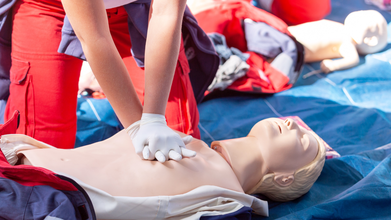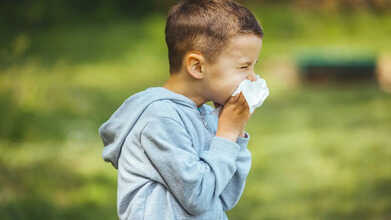- Health Conditions A-Z
- Health & Wellness
- Nutrition
- Fitness
- Health News
- Ayurveda
- Videos
- Medicine A-Z
- Parenting
- Web Stories
How Can You Help A Person Or Child Choking? New American Heart Association Guidelines Explains What To Do

(Credit-Canva)
The American Heart Association (AHA) has released its new "2025 CPR and Emergency Care Guidelines." This is the first full update to these life-saving rules since 2020. The new advice includes better ways to handle choking and suspected opioid overdose, along with other steps to save a life.
Every year, about 350,000 people in the U.S. experience sudden cardiac arrest outside of a hospital, and nearly 90% of them do not survive. The AHA’s new guidelines, its first full update since 2020, offer science-backed instructions that make emergency response easier for everyone to understand and apply.
What To Do When A Person Is Choking
The instructions for helping someone who is choking are now clearer and apply to all ages:
For Adults and Older Children (who are awake)
You should switch back and forth between giving five back blows (hits on the back) and five abdominal thrusts (the Heimlich maneuver). Keep doing this until the object comes out or the person passes out.
This is new for adults, and the old rules for children just said to do abdominal thrusts.
For Infants
You should switch back and forth between giving five back blows and five chest thrusts, which are pushes on the chest, using the heel of one hand. Keep going until the object comes out or the baby passes out.
Do not use abdominal thrusts on infants, as it could seriously hurt them.
How To Spot an Opioid Overdose
The guidelines have new advice for helping someone who might have overdosed on opioids. Opioids cause many drug overdose deaths because they slow down the part of the brain that controls breathing. Watch for these signs of a suspected opioid overdose:
- Breathing is slow, very shallow, or has stopped.
- Making choking or gurgling noises.
- Feeling very sleepy or passing out.
- The pupils (black centers of the eyes) are very small and tight.
- The skin, lips, or fingernails look blue or gray.
What You Need To Know About CPR
The AHA also worked with pediatric experts to update the rules for kids and newborns:
Helping Newborns
For most newborns who don't need immediate help, the updated rule now recommends a slight delay, asking doctors to wait at least 60 seconds before cutting the umbilical cord. This simple change is crucial for the baby's health, as it allows more blood to flow to the infant, improving their blood and iron levels.
Easier CPR Steps
The complicated, separate steps previously used to guide rescuers have been replaced with a single, simple "Chain of Survival." This new chain clearly stresses that when a person's heart stops, it is absolutely essential to quickly perform both chest compressions and rescue breaths, especially for infants and children, to give them the best chance of surviving.
Training Younger People
New research shows that kids who are 12 years old or older can be successfully trained to perform high-quality CPR and even learn to use a defibrillator. The American Heart Association wants everyone to take a class to learn these vital skills, encouraging more training programs and public education efforts so that communities are better prepared for medical emergencies.
The AHA urges everyone to take a CPR class to learn these life-saving skills. They are encouraging more training and public campaigns to make sure everyone is ready to help in an emergency
Atorvastatin Recall 2025: Safe Alternatives For Keeping Cholesterol In Check

Credits: CANVA
Atorvastatin Recall 2025: Statins have long been the first-line treatment for high cholesterol, but the Food and Drug Administration (FDA) has confirmed a nationwide recall of over 140,000 bottles of a cholesterol-lowering medication. Officials flagged that some pills may not dissolve properly after ingestion, potentially reducing effectiveness for patients who rely on them daily.
The recall affects Atorvastatin Calcium, the generic version of Lipitor, which is taken by roughly 39 million Americans, most of them adults over 40, according to Dr. Tamanna Singh of the Cleveland Clinic. Federal records show that the recalled batches were manufactured by Alkem Laboratories and distributed by Ascend Laboratories in New Jersey. The FDA’s September 19 enforcement report found that several batches failed quality tests designed to ensure proper dissolution of the pills.
If the pills dissolve inconsistently or more slowly than intended, the medication may not deliver the expected cholesterol-lowering effect. The FDA classified the recall as a Class II action, indicating moderate concern. While temporary or reversible side effects could occur, the likelihood of serious harm is low.
Atorvastatin Recall: Which Atorvastatin Tablets Are Affected
The recall covers multiple strengths and bottle sizes of Atorvastatin Calcium Tablets, which are among the most commonly prescribed statins globally. Affected formulations include:
- 10 mg – 90, 500, and 1,000 tablets per bottle
- 20 mg – 90, 500, and 1,000 tablets per bottle
- 40 mg – 90, 500, and 1,000 tablets per bottle
- 80 mg – 90 and 500 tablets per bottle
Cholesterol Medication Recalled: Safe Alternatives to Atorvastatin
If you are affected by the recall, there are several alternatives to help manage cholesterol levels effectively:
1. Ezetimibe (Zetia)
Ezetimibe is often recommended when a statin alone doesn’t sufficiently lower cholesterol. It may be used if you are on the maximum statin dose but your cholesterol remains high, or alongside statins such as atorvastatin or simvastatin for conditions like homozygous familial hypercholesterolemia.
Ezetimibe works by blocking cholesterol absorption in the small intestine, causing the body to use up more cholesterol from the blood. It is one of the few non-statin medications that can further reduce LDL cholesterol, either alone or combined with statins or other alternatives.
2. Fibrates (e.g., gemfibrozil, fenofibrate)
Fibrates mainly target high triglyceride levels, a type of fat in the blood linked to heart disease and pancreatitis, and can also mildly lower LDL cholesterol. They can be taken alone, with ezetimibe, or with a statin. However, combining gemfibrozil with a statin may increase side effects, so caution is advised.
3. Bile Acid Sequestrants (e.g., cholestyramine, colestipol, colesevelam)
Bile acid sequestrants lower cholesterol by binding bile acids in the intestine, preventing their reabsorption. The liver then uses more cholesterol from the blood to produce new bile acids, reducing LDL cholesterol.
Potential drawbacks include:
- Multiple pills per day may be needed
- Possible interactions with other medications or vitamins, which can reduce effectiveness
- May increase triglyceride levels
- Can cause constipation or stomach upset
Can A Tick Bite Make You Allergic To Meat? The Surprising Science Behind Alpha-gal Syndrome

Credits: Canva
Imagine sitting down to a juicy, perfectly cooked steak on a warm evening, and hours later you’re hit with terrible stomach cramps, itchy hives, and swelling so bad you might need to rush to the ER. The weird part? It’s not food poisoning, and the steak wasn’t bad. What’s actually happening is your own immune system is reacting, because of a tiny tick bite you got weeks or even months ago, one you probably don’t even remember.
What Is Alpha Gal Syndrome?
Alpha-gal syndrome is a food allergy that can develop after a tick bite, leading to allergic reactions to red meat and products made from it. While several types of ticks can trigger it, the lone star tick is the most common culprit. Not everyone who gets bitten will develop the allergy, but repeated bites can increase the risk or worsen symptoms, as per Cleveland Clinic.
What Can Trigger an Alpha-gal Reaction?
You may have an allergic reaction to:
- Meat from mammals, such as beef, pork, or lamb
- Foods or products made with animal fat
- Certain medications
- Cow’s milk and dairy products
Alpha-gal is a sugar molecule found in most mammals (except humans) and in tick saliva. Not everyone who is bitten by a tick develops alpha-gal syndrome, and you might not react to every food or product that contains it.
Symptoms of Alpha-gal Syndrome
Alpha-gal syndrome can cause reactions ranging from mild to life-threatening. Common symptoms include:
- Skin changes, like itching, hives, or flushing
- Swelling of lips, eyelids, throat, tongue, or face (angioedema)
- Respiratory issues, such as cough, shortness of breath, or wheezing
- Digestive problems, including stomach pain, diarrhea, heartburn, nausea, or vomiting
- Dizziness or fainting
- Joint pain
Timing of Symptoms
Unlike most food allergies, reactions to alpha-gal can occur two to six hours after eating meat or dairy. Medications containing alpha-gal may trigger a faster reaction.
Causes of Alpha-gal Syndrome
Alpha-gal syndrome develops after a tick bite, most commonly from the lone star tick, though bites from black-legged (deer) ticks and other species can also cause it. Ticks carry alpha-gal molecules in their saliva, and exposure during a bite can make your immune system recognize alpha-gal as a threat, triggering an allergy.
Experts aren’t certain why some people develop the allergy while others do not. Repeated tick bites can worsen symptoms or make reactions more frequent.
What Is Lone Star Tick?
The lone star tick is a tiny bug, sometimes as small as a poppy seed. Adult female lone star ticks are easy to identify by the white dot on their backs, the “lone star.” They are commonly found in and around wooded areas across the Midwestern and Eastern United States.
Having alpha-gal syndrome is not just about giving up burgers or steaks. Like other food allergies, it can affect a range of products you may need to avoid. While caution is important, most people with AGS won’t react to every item that contains alpha-gal, and for some, symptoms may improve within a few years. Your healthcare provider can guide you on which foods to steer clear of and what to expect in your individual case.
Think You Have Flu or Covid? Your ‘Winter Cold’ Could Be Hiding THIS Serious Condition

Credits: Canva
Sniffles and other symptoms often mistaken for a winter virus such as Covid or flu could actually be caused by something else, according to a pharmacist. George Sandhu, deputy superintendent at Well Pharmacy, explained that pollen allergies are now extending into autumn as seasons stretch longer.
He said: “Warmer temperatures are lengthening growing seasons, so pollen counts are higher than in past decades. Rising carbon dioxide levels don’t just warm the planet, they also act like a fertiliser for plants, increasing pollen production.”
What Is a Pollen Allergy?
A pollen allergy happens when your immune system reacts to pollen, which is a fine powder released by trees, grasses, and weeds during reproduction. In people with this allergy, the immune system mistakes pollen for a harmful substance and releases chemicals such as histamine.
This can trigger symptoms like sneezing, runny or blocked nose, itchy or watery eyes, and throat irritation. This condition is commonly called hay fever and tends to appear during certain times of the year when specific plants are blooming, according to the Cleveland Clinic.
Sandhu added that milder winters are allowing some plants to start producing pollen earlier in spring and continue later into autumn. He noted: “Late summer also sees a shift from weed pollen to increased indoor mould, leaf mould, and dust mites, which all peak during autumn. Combined with damp autumn conditions, people with allergies now face a much longer ‘high-risk window’ every year.”
Types of Pollen Allergens
The pharmacist explained the three main types of allergens:
- Weed pollen: including ragweed, mugwort, plantain, nettle, dock, goosefoot, and sorrel.
- Mould spores: thrive in damp autumn conditions and can be found in rotting leaves, compost heaps, soil, as well as bathrooms, kitchens, and other damp areas.
- House dust mites: found in bedding, carpets, soft toys, and fabrics.
Best Treatment for a Pollen Allergy
The best way to manage pollen allergies depends on how severe they are and what suits your body. What helps one person may not work for another. A healthcare provider can recommend the most effective treatment. According to Sandhu, “Antihistamines can relieve sneezing, runny nose, and itching, for example, cetirizine or loratadine. Nasal corticosteroid sprays, such as fluticasone or mometasone, reduce inflammation and congestion. Decongestants may give short-term relief for a blocked nose, but they shouldn’t be used long-term. Saline sprays or rinses can help clear allergens from the nose, and eye drops can soothe itchy, watery eyes.”
Can Allergy Shots Work Against Pollen Allergy?
Allergy shots gradually retrain your immune system to tolerate pollen. They involve a series of injections containing pollen, with the dose slowly increased over time. This helps your body build tolerance. Allergy shots are administered by a healthcare provider.
While it is impossible to avoid pollen completely, you can change some daily habits to reduce exposure. For instance, try not to be outside on warm, windy spring days when pollen levels are high. Pollen counts are usually highest in the early morning and early afternoon.
© 2024 Bennett, Coleman & Company Limited

